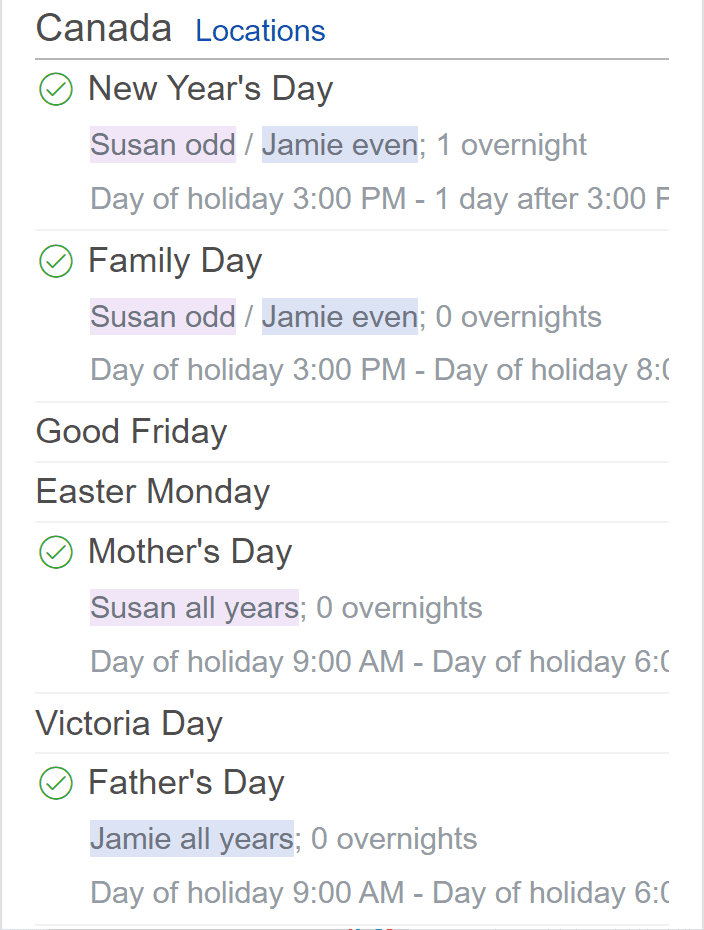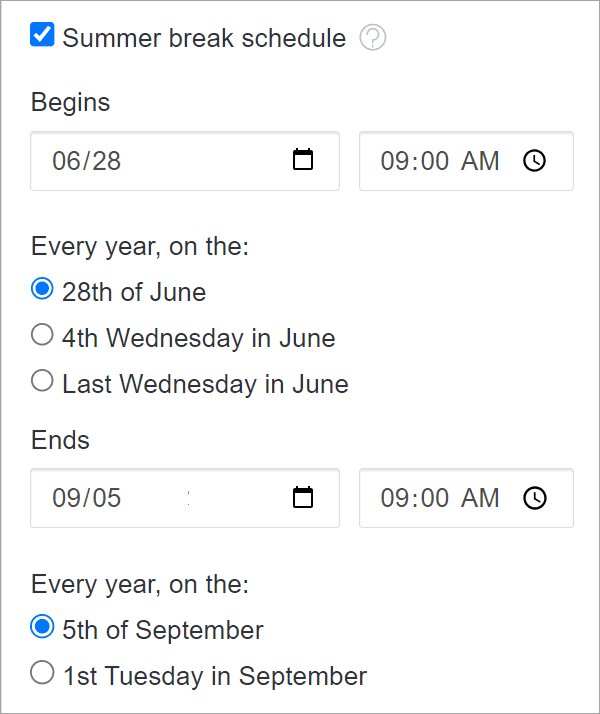Saskatchewan Parenting Time Schedules
Parenting time schedules explain when the child will be in the care of a parent. Sometimes they also show when a third party will care for the child. Although some parents choose to go without a schedule, a schedule is important because it emphasizes the child's right to spend time with each parent (so long as that's safe). It also reduces the back-and-forth necessary for planning impromptu transitions.
When you submit a schedule to the court, it must be in writing. Use clear, specific language that takes future years into account. Adding a visual calendar is optional.
Reaching agreement
Many parents agree on a schedule and include it in a parenting plan. With court approval, this becomes their "permanent" schedule — at least until a court changes it if it no longer suits their situation.
If parents cannot agree, each proposes a schedule to the court. The judge will consider the proposals when making the final parenting order but can choose a different schedule if they think it would better suit the child's best interests.
Shared parenting time
Shared parenting time is when the child spends at least 40 percent of the year with each parent. It is often regarded as the most beneficial parenting arrangement since it keeps both parents regularly involved in the child's life. However, it is not appropriate for every situation.
There are many ways to represent shared parenting time in a schedule.
The alternating weeks schedule (also called one week on, one week off) is the most popular schedule for parents who split parenting time 50/50. It has your child live with one parent for a full week, then switch to the other parent's care for a full week.
 You can customize this with Custody X Change.
You can customize this with Custody X Change.
Alternatively, you can split up the week so the child can spend time with both parents every week.
The 2-2-3 schedule places your child with one parent for two days, then with the other parent for two days, before they return to the first parent for three days. Each parent gets 50 percent of annual parenting time. Parents switch days each week.
 You can customize this with Custody X Change.
You can customize this with Custody X Change.
A common schedule for parents who split parenting time 60/40 is the 4-3 schedule. It has your child stay with one parent for four days of the week before going to the other parent's home for three days. This schedule has static days, meaning each parent receives the same days of the week every week.
 You can customize this with Custody X Change.
You can customize this with Custody X Change.
Majority parenting time schedules
In some situations, it's best for one parent to have more than 60 percent of annual parenting time. For example, if the child has not spent much time with one parent, easing the child into spending time with the parent will help them adjust. If you follow a step-up parenting plan, you may eventually transition to a shared arrangement.
In a majority parenting time arrangement, it's most common for the child to visit the noncustodial parent on weekends.
With the alternating weekends schedule, the child visits the noncustodial parent every other weekend. The schedule below gives one parent 80 percent of annual parenting time and the other 20 percent.
 You can customize this with Custody X Change.
You can customize this with Custody X Change.
Many parents add a short midweek visit every other week so the child can visit the noncustodial parent when they don't have a visit upcoming that weekend.
 You can customize this with Custody X Change.
You can customize this with Custody X Change.
The every weekend schedule means the child spends every weekend with the noncustodial parent. The noncustodial parent gets more of the annual parenting time (30 percent) than they would with an alternating weekends schedule.
 You can customize this with Custody X Change.
You can customize this with Custody X Change.
For either schedule, you can give the noncustodial parent more or less time by adjusting when the weekend begins and ends.
Holidays and vacations
Designating holidays and vacations in a schedule eases anxiety over where the children will be during special occasions.
For holidays, some parents choose to follow their regular schedule. The parent who would normally have parenting time on that day gets the holiday.
Most split up holidays, with each parent getting half of the holidays within a year. Generally, if a parent gets a holiday one year, the other parent gets it the next year. If there are holidays only one parent celebrates, they could get that time every year.

You can create a schedule specifically for summer break.

Set the summer schedule's start time as the child's last day of the school year and the end time as the child's first day back. Then pick a schedule that you'll follow during this time.
Often, one parent has the child for all of July, while the other has them for all of August. Or the noncustodial may get the majority of both months to make up for their lesser share of parenting time during the rest of the year.
When it comes to vacationing with the child, it's common to allocate a certain number of days a year to each parent. You can specify if vacations must be taken during summer break or other particular times.
The easiest way to make a schedule
If you're like most parents, creating a parenting time schedule will feel daunting. How do you address holidays, school breaks and birthdays while ensuring the schedule will work in the years to come?
The Custody X Change app makes it easy. First, click and drag in your colour-coded calendar.
Try this with Custody X Change.
Then watch as your choices automatically apply to future years and a full description appears in your Custody X Change parenting plan.
 You can customize this with Custody X Change.
You can customize this with Custody X Change.
The combination of a visual and written schedule means your family will have no problem knowing who has the child when. Take advantage of Custody X Change to make your schedule as clear and thorough as can be.
